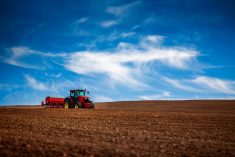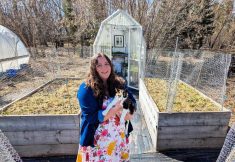The question is, should you care? The global merger of Dow and DuPont means that some of the most famous names in farm history are getting roped together under an entirely unknown name — “Corteva.”
And somehow, all of us in agriculture are supposed to be persuaded to not only learn the new name, but believe that there’s enough of a potential win for us in it to make it worth remembering.
And that’s not all. Within three to five years, we’re supposed to be thinking so positively about this new brand that we will prefer to do business with it rather than Bayer, BASF or Syngenta.
Read Also

Five pieces of unconventional wisdom that can help you reach your goals
Using unconventional wisdom to achieve new year goals on your farm.
In an industry that seems to churn out a mittful of new product and company names every two days, that’s a challenge.
Already, though, the fog is beginning to lift, and we’re getting a much better sense of how to judge what kind of company this new entity wants to be, how it plans to develop its brand, and whether it’s hitting the marks that it believes it must hit.
We may even be getting closer to answering the most critical question of all. Does Corteva really believe what it’s saying?
Since late 2015 when the boards of Dow and DuPont jointly announced their plans for their US$130 billion “merger of equals,” they have consistently pointed to the US$4 billion in annual cost savings and growth synergies that they expect the deal to net.
But they have also been clear that this is the thin edge of wedge. From the beginning, Ed Breen, chief executive officer of the interim DowDuPont has also said that much bigger dollars will come from the plan to separate the merged businesses into three stand-alone companies, namely agriculture, materials and specialty products.
Each of the three, Breen says, is expected to become a “powerhouse” company in its sector, taking advantage of “clear focus, market visibility, and more productive R & D.”
How does that play out for farmers in Canada? Is it good news?
In the last 18 months, major progress has been notched on two key targets. First, most regulatory issues have been resolved (which included the sale of DuPont cereal herbicides to FMC), and the legal wheels have been set in motion to formally launch Corteva AgriScience in Canada next June.
That hasn’t been simple, of course. After all, DowDuPont has annual sales of US$80 billion, including US$14 billion in agriculture, $44 billion in materials, and $21 billion in specialty products.
Equally important, however, Corteva has now shown how it intends to do business: adopting a proven MBA strategy of first articulating its values and its purpose. It’s a mouthful, but when Country Guide recently interviewed Canadian lead Bryce Eger, they were practically the first words he spoke:
“We are driven by our beliefs and our purpose, which is to enrich the lives of those who produce and those who consume, ensuring progress for generations to come.”
Get ready to hear it again and again. If the words sound today like they could call to mind myriad companies that have said similar things in the past, Eger is promising that that’s going to change, and that starting next year, if someone talks about “enriching those who produce and those who consume,” you’ll instantly think Corteva.
Can he do it? It sounds like a big promise for a name that few Canadian farmers know how to pronounce. (It’s Cort-ev-uh, almost like saying “forever” but dropping the final “r.” And by the way, it’s derived from “cor,” which is Latin for heart, and “tev,” which is a 14,000 year old Hebrew word having to do with nature.)
Eger is confident the company will bring the firepower needed for success. The new company will be the only one of the Big 4 that is a pure-play agriculture company. He says this is already creating excitement among staffers, and that its advantages will soon be obvious to customers too.
“It requires us to think differently,” Eger says. “We aren’t a part of a conglomerate any more… everyone in the organization is going to wake up every day thinking about the farmer.”
It’s also enabling a flattening of the company’s decision-making processes. For example, Eger now reports directly to Judd O’Connor, regional vice-president for North America, who reports directly to Jim Collins, chief operating officer. Similar examples are being developed at every turn, including more direct access from the field to the top levels of research.
Eger says it will not only affect the speed of their decision-making, but also the quality of their thinking. “Because everyone in the organization is ag-based, there’s a different way for us to think about bringing products to the marketplace.” Plus, the change means the company can focus more on the quality of its individuals and their ability to interconnect, spending less time on formal structures. As Eger explains it, “My job is to enable them to do the things they need to do and get out of their way… clear the ice so they can go and play the game.”
“When we do that, the opportunity is to expand the size and scope and scale of the business,” Eger says. “That’s why we exist… to expand and to grow.”
So that’s part of the test. Within the next few years, will Canadian farmers differentiate Corteva based on its responsiveness and on the quality of its products? Most important, as Eger says, will they say to themselves, it’s from Corteva, so it’s going to be good?
Part of his challenge is that Corteva will go to market under a series of brands. For instance, the company will keep the Pioneer brand, noted especially for its corn and soybeans. (There was scuttlebutt that Pioneer was going away,” Eger says. “That would have been absolutely nuts, getting rid of a brand that’s neck and neck with John Deere.”)
The difference is, under the new configuration, Pioneer will be the brand for those seed sales, but Corteva will be the company. Similarly, the new Brevant brand will be the logo for Dow lines such as Dow Seeds, D-Series and Nexera, although Corteva is the company.
Eger is promising that Corteva won’t try to re-invent the marketing channel. Pioneer will still have its dealers in the field, and Brevant will mainly be sold through existing retailers (although background calls to retailers and dealers confirm that there’s some anxiety in the field about how exactly this will work out, and whether and how much the sales channel will be rationalized).
Crop protection will be sold under the Corteva name, but increasingly the company will also be selling digital technology products, witness recent developments with farm management software via Granular and Encirca agronomy software. Much more is to come, Eger says.
Creating awareness of the company while selling through product brands and brand lines adds complexity to the job of Canadian marketing manager Brad Orr. It’s also a job that is complicated by the fact that the existing Dow and DuPont names are so entrenched in Canada’s farm vocabulary.

In a way, it might seem there’d be little harm if progress toward Corteva is less than at rocket speed, since it isn’t as if the company is racing away from negative or unpopular legacy names. But it doesn’t take long to see that Orr thinks the real goal is to make progress on the change to Corteva in order to take advantage of the strengths that the new brand brings, ranging from its pure-play format to its focus on communicating with consumers.
And, as with his boss, it’s only a minute into our conversation with him that we hear the “enriching the lives of those who produce and those who consume,” mnemonic.
To date, most of the Corteva marketing effort has been targeted internally, so staff and the sales team can start embodying the new direction, which in itself will prove a key differentiator that farmers will notice, Orr says. Already, he says, “It feels different compared to the legacy companies.”
Orr says there’s also been quick response to the concept that the best route forward is to focus on giving farmers more effective and more profitable tools that are also better for the consumer, both because of the quality and quantity of food that can be produced with them and also because they help sustain environmental quality.
The quick response is what was projected, based on intensive DowDuPont research into the opportunities for Corteva to brand itself as a different sort of company.
Still, Orr says, there’s much hard work ahead, especially on the “enriching the lives of consumers” front. It’s a core purpose, and is being given that level of attention. But, adds Orr, “It’s a new path. We’re building the road as we go along.”
But Canadian farmers will soon start seeing a difference, says Canadian manager of marketing communications, Loralee Orr. When Corteva launches new products, she says, not only will it talk about agronomic benefits, the advertising will also help farmers talk to non-farmers about why they’ve chosen to use the product, and why it benefits consumers too.

Corteva won’t just talk to audiences that have always been friendly to agriculture, the company says. It will also connect with detractors.
It will be a differentiator, Eger says.
How will he know the company is on path with its implementation of the new brand plan? There will be close analysis and sales and marketing statistics, of course, but Eger says his eye is on something a bit different.
“As we get closer to the June date, there’s got to be some recognition from our farmer customers and our channel partners that this feels different,” Eger says.
There’s got to be some noise around Corteva, he adds. And over the next couple of years, farmers and others in agriculture have to start showing that they perceive Corteva as the kind of organization they want to work with. New graduates have to be asking: How do I get a job with Corteva, he adds, and thought-leaders have to start insisting that Corteva be around the table when important issues get discussed.
“If we score on those things, the business stuff will be quite easy,” Eger says. “Farmers will choose to do business with us because of the quality of the products we have, the quality of the people we have, and the voice we have for the industry.”
It’s the stake the company is putting in the ground for all to see.
















